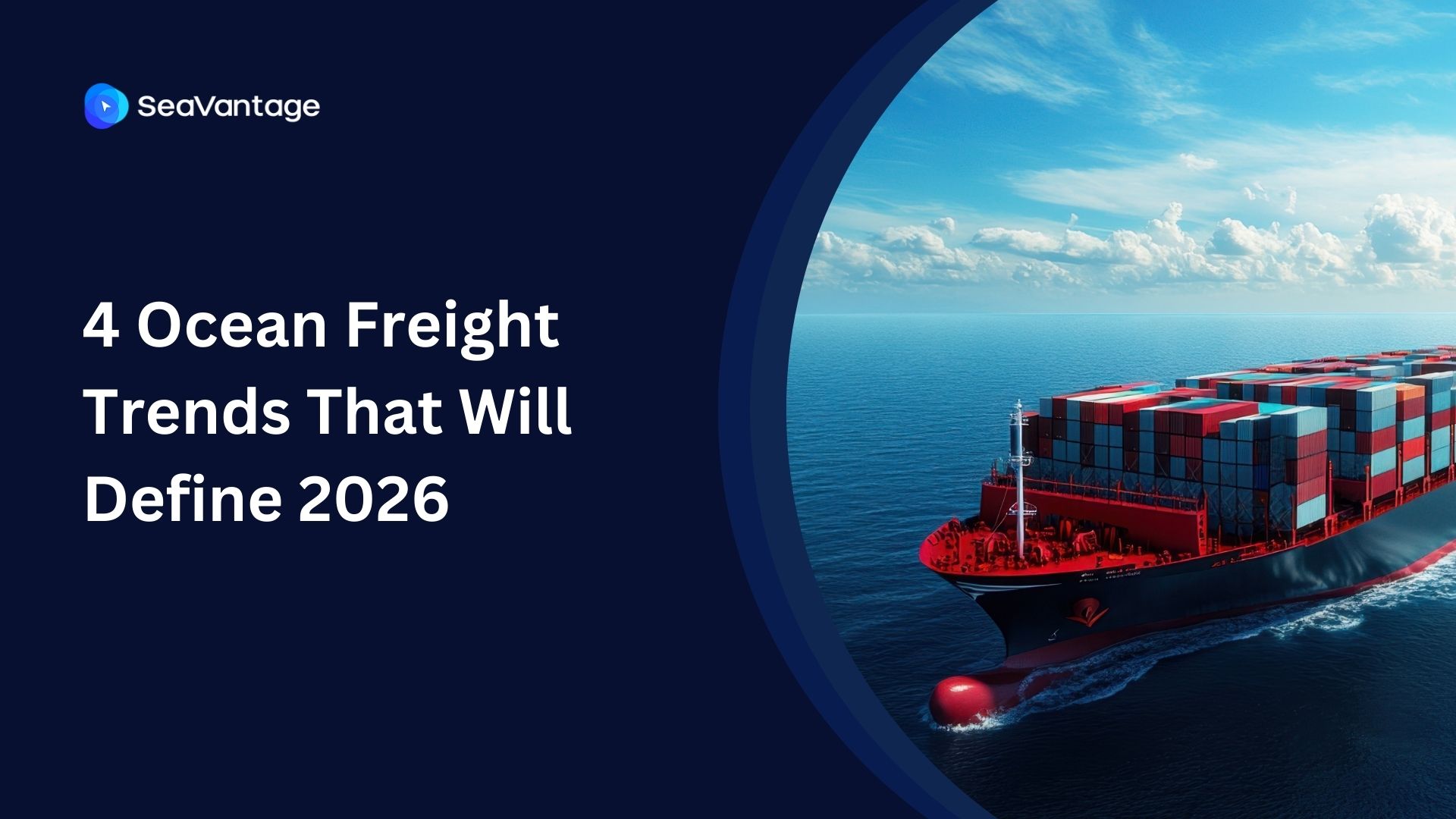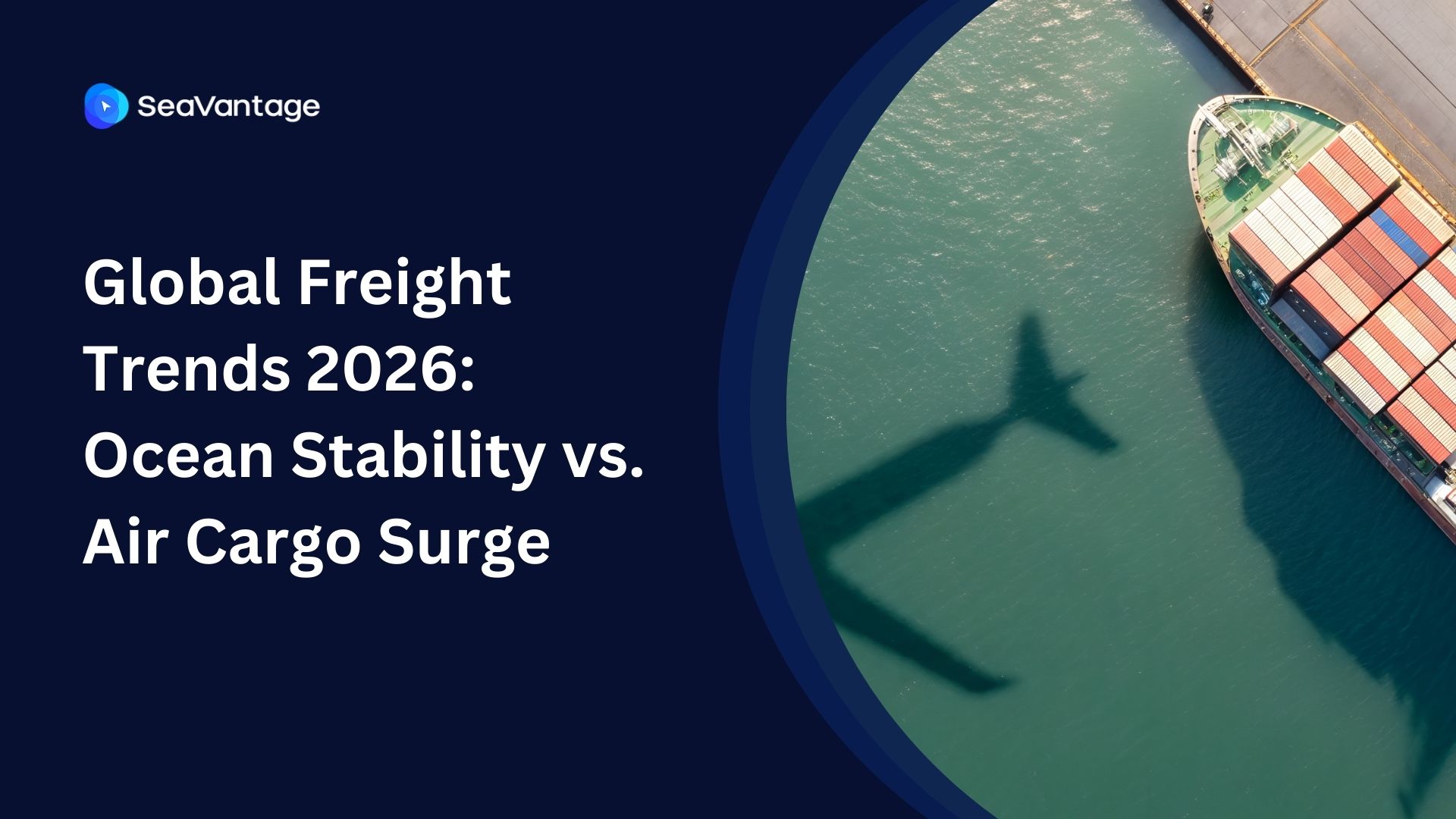Transshipment in Container Tracking: What You Need to Know 2024

The world runs on ocean freight—over 90% of goods rely on maritime transport. That's a staggering amount of cargo moving across the globe, and transshipment plays a pivotal role in this massive operation. But what exactly is transshipment, and why is it so important?
The Global Impact of Container Shipping
Container shipping is the backbone of international trade, enabling the movement of goods across continents. With millions of containers in transit at any given time, the efficiency of this system is crucial. Transshipment hubs, like those in Singapore and Rotterdam, act as vital nodes, ensuring that cargo reaches its final destination smoothly.
Transshipment in Simple Terms
Transshipment is the process of transferring containers from one vessel to another at an intermediate port. Think of it as a layover for your cargo. This method is essential for optimizing shipping routes and reducing costs, allowing goods to be rerouted efficiently to their final destinations.
The Role of Container Tracking in Transshipment
In the world of maritime logistics, container tracking is indispensable. It provides real-time visibility into the location and status of containers, ensuring supply chain transparency. Advanced tracking systems use technologies like GPS and IoT sensors to monitor containers, making transshipment operations more reliable and efficient.
Understanding Transshipment Fundamentals
What is Transshipment?
Transshipment is a pivotal process in maritime logistics, where containers are transferred from one vessel to another at an intermediate port, known as a transshipment hub. This operation is crucial for connecting different shipping routes, and ensuring that containers reach their final destinations efficiently. By facilitating the movement of goods across vast distances, transshipment plays a vital role in global connectivity and supply chain transparency.
Types of Transshipment Operations
- Hub-and-Spoke Model: This model involves central hubs where containers from various origins are consolidated and then dispatched to their final destinations. It optimizes shipping routes and reduces costs.
- Relay Transshipment: In this type, containers are transferred between vessels that operate on different legs of a journey, allowing for efficient long-distance shipping.
- Interlining: This involves the transfer of containers between different shipping lines, enhancing flexibility and connectivity in maritime logistics.
Key Players in Transshipment
Transshipment operations involve a range of stakeholders, each playing a critical role in ensuring smooth logistics. These include:
- Carriers: Shipping lines that transport containers across the globe.
- Port Operators: Entities responsible for managing port facilities and ensuring efficient container handling.
- Logistics Providers: Companies that coordinate the movement of goods, ensuring timely delivery and container visibility.
Challenges in Transshipment Logistics
Despite its benefits, transshipment logistics face several challenges:
- Complex Coordination: The need for precise coordination among multiple stakeholders can complicate operations.
- Port Congestion: High traffic at transshipment hubs can lead to delays, impacting overall efficiency.
- Risk of Container Loss: The transfer process introduces risks such as loss or damage to containers.
The Evolution of Container Tracking in Transshipment
Historical Methods of Tracking
In the early days of maritime logistics, tracking transshipped containers was a labor-intensive process. Port operations relied heavily on manual documentation and communication via radio or telephone. This method was not only time-consuming but also prone to errors, leading to inefficiencies in container visibility. The lack of real-time tracking meant that stakeholders often had to wait for updates, which could delay decision-making and increase costs.
Technological Advancements in Tracking
With the advent of technology, container tracking has undergone significant transformations. The introduction of GPS tracking systems revolutionized the way containers were monitored, providing real-time location data. IoT sensors further enhanced this capability by offering insights into the condition of the cargo, such as temperature and humidity levels. Blockchain technology has also emerged as a game-changer, ensuring supply chain transparency by creating immutable records of each container's journey. These advancements have made transshipment monitoring more efficient and reliable.
Current State of Container Tracking
Today, container tracking systems are more sophisticated than ever. They integrate various technologies to provide comprehensive data on container movements. Real-time tracking platforms offer stakeholders instant access to information about a container's status, location, and estimated time of arrival. This level of container visibility is crucial for optimizing port operations and ensuring timely deliveries. The integration of these systems with other logistics platforms allows for seamless information sharing, enhancing the overall efficiency of maritime logistics.
Digitalization's Impact on Transshipment
Digitalization has had a profound impact on transshipment operations. By automating many of the processes involved in container tracking, digital solutions have reduced the risk of human error and improved the accuracy of data. Real-time tracking and monitoring platforms enable stakeholders to make informed decisions quickly, reducing delays and costs. The use of predictive analytics, powered by AI and machine learning, allows for better resource allocation and risk mitigation. As a result, the digitalization of container tracking has not only enhanced supply chain transparency but also improved the overall efficiency of transshipment operations.
Key Components of Modern Container Tracking Systems
Hardware Components
In the realm of container tracking, hardware components play a pivotal role. These include sensors, trackers, and beacons that are affixed to containers. These devices are designed to withstand harsh maritime conditions and provide real-time data on the container's location and status. For instance, GPS trackers offer precise location data, while IoT sensors can monitor environmental conditions like temperature and humidity, crucial for sensitive cargo.
Software Solutions
The software side of container tracking is equally important. Platforms, apps, and interfaces are developed to process and display data collected by hardware components. These solutions offer user-friendly dashboards that provide insights into container movements and status. Advanced software can integrate with existing systems, offering seamless updates and alerts. This integration is vital for maintaining container visibility throughout the transshipment process.
Integration Capabilities
Modern tracking systems are designed with integration in mind. They can connect with various stakeholders, including shipping lines, port authorities, and logistics providers. This is achieved through API integration, which allows different systems to communicate and share data efficiently. For example, when a container is transshipped at a hub port, the system automatically updates its status, location, and estimated arrival time, making this information instantly available to all authorized parties.
Data Management Systems
Effective data management is crucial for supply chain transparency. Modern systems collect vast amounts of data, which must be stored, processed, and analyzed. Robust data management systems ensure that this information is accurate and accessible. They support real-time tracking and provide historical data for analysis, helping stakeholders make informed decisions. These systems also play a role in transshipment monitoring, ensuring that all parties have access to the same information, reducing the risk of errors and delays.
Benefits of Advanced Container Tracking in Transshipment
Real-Time Visibility
In the fast-paced world of maritime logistics, having real-time visibility into container movements is a game-changer. Advanced container tracking systems provide up-to-the-minute updates on the location and status of containers, ensuring that all stakeholders are informed. This level of transparency enhances supply chain transparency and allows for quick responses to any disruptions. For instance, if a container is delayed at a port, real-time alerts can help logistics managers adjust plans accordingly, minimizing potential impacts on the supply chain.
Improved Decision-Making
With access to comprehensive data through container tracking systems, decision-makers can make more informed choices. The integration of data from various sources, such as GPS and IoT sensors, provides a holistic view of the supply chain. This information is crucial for optimizing port operations and ensuring that resources are allocated efficiently. By analyzing trends and patterns, companies can anticipate potential bottlenecks and proactively address them, leading to smoother transshipment processes.
Risk Mitigation
Transshipment operations are fraught with risks, from potential delays to the loss of containers. Advanced tracking technologies play a vital role in risk mitigation by providing detailed insights into the journey of each container. Real-time monitoring platforms can alert stakeholders to any deviations from the planned route, allowing for immediate corrective actions. This proactive approach reduces the likelihood of costly disruptions and ensures that goods reach their destinations safely and on time.
Cost Reduction
Implementing advanced container tracking systems can lead to significant cost reductions in transshipment operations. By optimizing shipping routes and improving resource allocation, companies can minimize unnecessary expenses. Real-time data allows for better planning and scheduling, reducing idle times and enhancing the efficiency of port operations. Additionally, the ability to track containers accurately reduces the risk of lost or misplaced shipments, further cutting down on potential financial losses.
Common Challenges and Solutions
In the world of transshipment, container tracking is essential, but it comes with its own set of challenges. Let's explore some of the common issues and their potential solutions.
Connectivity Problems in Ocean Transport
One of the biggest hurdles in maritime logistics is maintaining reliable connectivity. The vastness of the ocean can lead to signal loss, making real-time tracking difficult. To combat this, many companies are turning to satellite technology and IoT devices that provide continuous data transmission, even in remote areas. These advancements ensure that container visibility is maintained throughout the journey.
Data Standardization Issues
Data standardization is crucial for supply chain transparency. Different stakeholders often use varied systems, leading to inconsistencies. Implementing universal data standards can help streamline information flow. Organizations are increasingly adopting blockchain technology to create a unified data platform, ensuring that all parties have access to accurate and consistent information.
Equipment Compatibility
Compatibility between different tracking systems and equipment can be a significant challenge. Diverse hardware and software solutions may not always integrate seamlessly. To address this, companies are investing in flexible systems that support multiple communication protocols and can easily adapt to various technologies, enhancing overall efficiency in port operations.
Information Sharing Between Stakeholders
Effective information sharing is vital for successful transshipment monitoring. However, privacy concerns and competitive interests can hinder open communication. Establishing secure data-sharing platforms that protect sensitive information while allowing necessary access can foster collaboration among carriers, port authorities, and logistics providers. This approach not only improves decision-making but also enhances customer service by providing timely updates.
Future Trends and Innovations
AI and Machine Learning Applications
Artificial intelligence and machine learning are revolutionizing transshipment and container tracking. These technologies enable predictive maintenance, optimize shipping routes, and enhance decision-making processes. By analyzing vast amounts of data, AI can identify patterns and predict potential disruptions, allowing for proactive measures. For instance, AI-driven systems can forecast port congestion, helping logistics managers reroute shipments to avoid delays.
Predictive Analytics
Predictive analytics is becoming a cornerstone in maritime logistics, offering insights that were previously unattainable. By leveraging historical data and real-time information, predictive models can estimate arrival times, assess risks, and suggest optimal transshipment strategies. This not only improves container visibility but also enhances supply chain transparency, ensuring that stakeholders are informed and prepared for any eventualities.
Smart Container Technologies
Smart containers are equipped with IoT sensors and real-time tracking devices, providing unparalleled container visibility. These technologies monitor various parameters such as temperature, humidity, and location, ensuring that goods are transported under optimal conditions. Smart containers also facilitate transshipment monitoring, offering stakeholders real-time updates on container status and location. This innovation not only enhances customer service but also mitigates risks associated with container damage or loss.
Conclusion
Transshipment plays a pivotal role in the global supply chain, acting as a bridge between different shipping routes. It involves the transfer of containers at intermediary ports, which can optimize shipping routes and reduce costs. The integration of advanced container tracking systems has revolutionized this process, offering real-time visibility and improving decision-making. These systems utilize technologies like GPS, IoT sensors, and blockchain to provide accurate and timely information, enhancing supply chain transparency and efficiency.
Container tracking is essential in transshipment operations, providing stakeholders with real-time updates on container status and location. This visibility is crucial for mitigating risks, reducing delays, and ensuring efficient port operations. By leveraging modern tracking technologies, companies can enhance customer service and allocate resources more effectively. The ability to monitor containers in real-time also supports better decision-making and cost management, making it an indispensable tool in maritime logistics.
Looking Ahead: The Future of Transshipment
The future of transshipment is set to be shaped by emerging technologies such as AI, machine learning, and smart container innovations. These advancements promise to further enhance container visibility and supply chain transparency. Predictive analytics and autonomous systems are expected to streamline operations, while blockchain integration will improve data security and information sharing. As the industry continues to evolve, embracing these innovations will be key to maintaining competitive advantage and meeting the growing demands of global trade.
FAQs
What is the purpose of transshipment?
Transshipment plays a vital role in global logistics by connecting different shipping routes. This process allows goods to be transported efficiently across vast distances, optimizing the use of shipping resources and reducing costs. By transferring containers at strategic transshipment hubs, shipping lines can consolidate cargo from multiple origins onto a single vessel, enhancing global connectivity.
How does transshipment affect shipment tracking?
Transshipment can complicate shipment tracking due to the multiple vessel changes involved. However, with the advent of real-time tracking solutions, such as GPS and IoT sensors, the status of containers can be monitored throughout their journey. These technologies provide updates on departure and arrival times, vessel changes, and estimated time of arrival (ETA), ensuring that stakeholders have visibility into the container's location and status at all times.
What are the key benefits of using transshipment hubs?
Transshipment hubs offer several advantages, including optimized resource use, cost savings, and enhanced global connectivity. By consolidating cargo at these strategic locations, shipping lines can utilize more economical routes and vessels, reducing overall transportation costs. Additionally, transshipment hubs facilitate the connection of different shipping routes, enabling goods to be transported across long distances more efficiently.
How can I track my containers during transshipment?
Tracking containers during transshipment can be done through various methods. Many carriers offer online tracking services where you can enter your Bill of Lading number to get updates on your container's status. Advanced real-time tracking solutions, such as those using Maritime AI™ technology, provide comprehensive visibility into the container's journey, including real-time updates on location, vessel changes, and ETA predictions. These tools ensure that you have access to accurate and timely information about your shipment.
2025년 9월, 주요 글로벌 항만에서 어떤 운송사가 가장 긴 선박 체류 시간을 기록했는지 확인해보세요. 트렌드를 비교하고, 지연을 파악하며, 전체 항만 데이터를 통해 운송 전략을 최적화할 수 있습니다.
2025년 8월, 주요 글로벌 항만에서 어떤 운송사가 가장 긴 선박 체류 시간을 기록했는지 확인해보세요. 트렌드를 비교하고, 지연을 파악하며, 전체 항만 데이터를 통해 운송 전략을 최적화할 수 있습니다.
2025년 7월, 주요 글로벌 항만에서 어떤 운송사가 가장 긴 선박 체류 시간을 기록했는지 확인해보세요. 트렌드를 비교하고, 지연을 파악하며, 전체 항만 데이터를 통해 운송 전략을 최적화할 수 있습니다.
iscover the 4 critical ocean freight trends for 2026, from the Red Sea reopening and fleet overcapacity to shifting global trade maps. Prepare your supply chain now.
Discover key 2026 freight market trends: Port of Houston expansion, air cargo "super peak," and ocean freight stability. Plan your supply chain with SeaVantage.
Explore November 2025 global port dwell time data. See which ports and carriers led in efficiency across Antwerp, Busan, Long Beach, Rotterdam, and Singapore.



.svg)





.jpg)

.png)